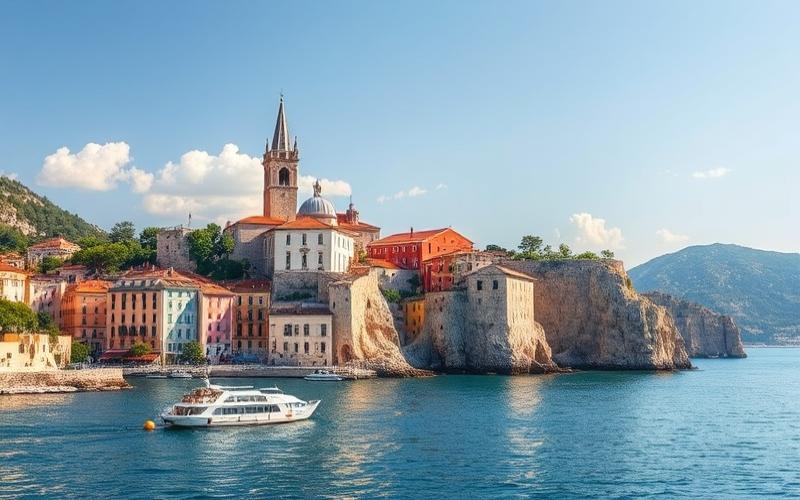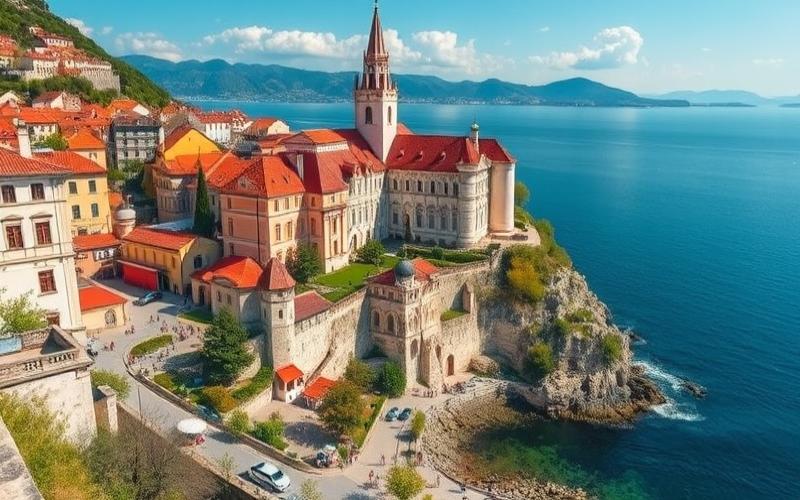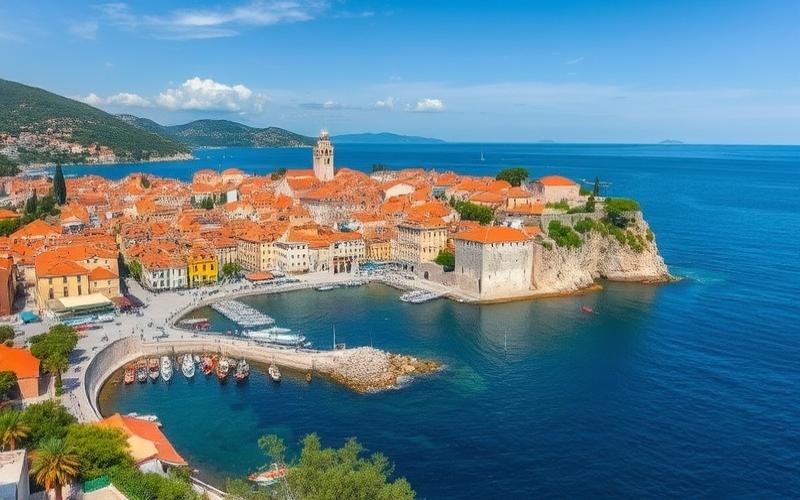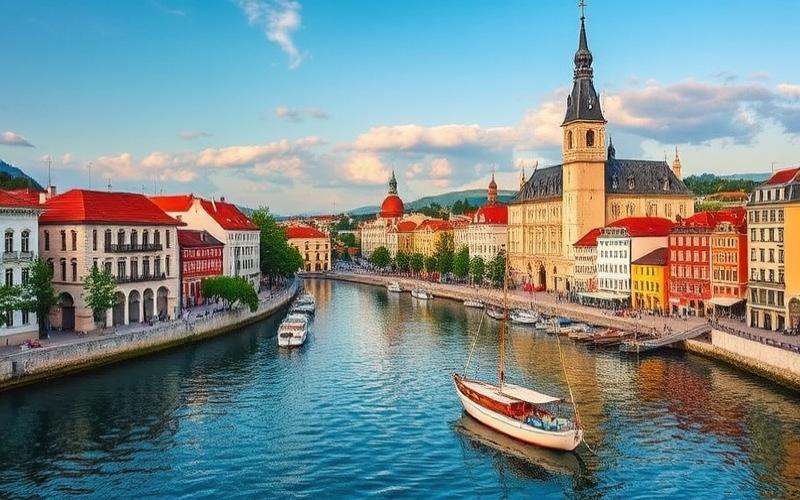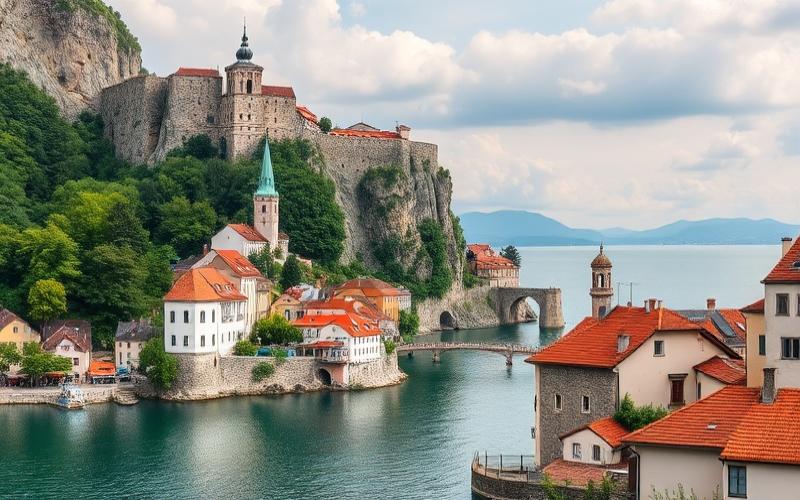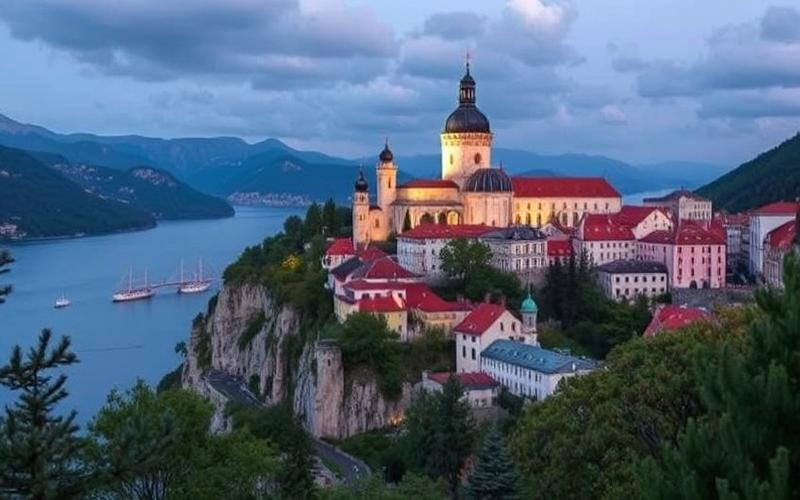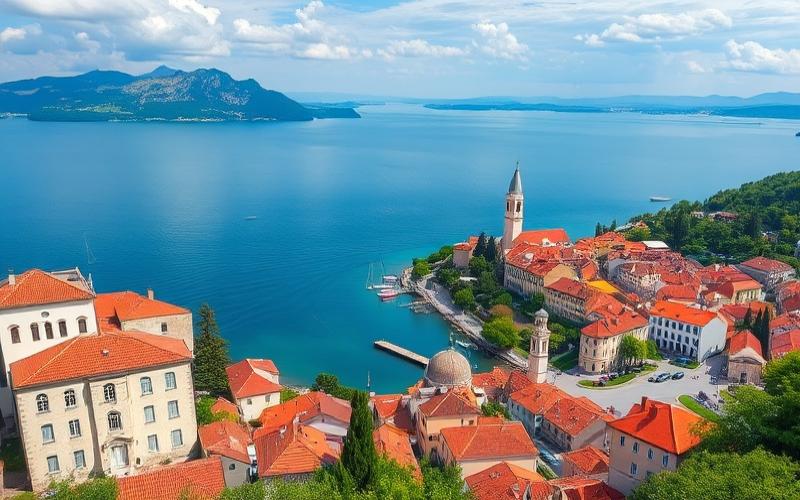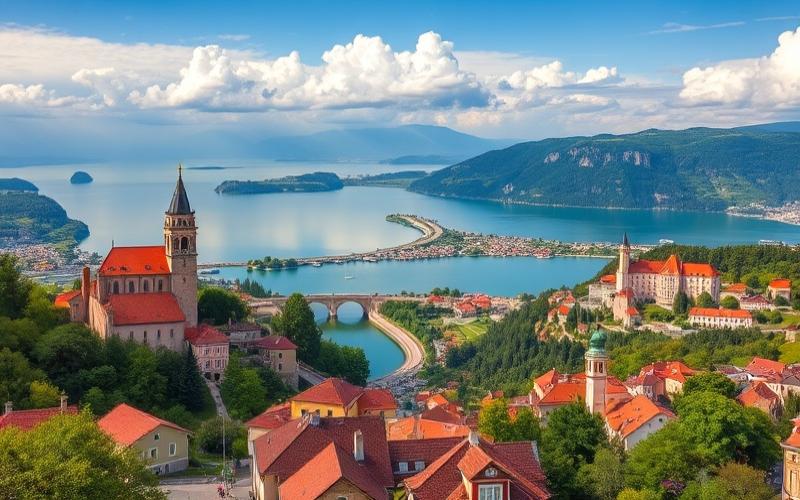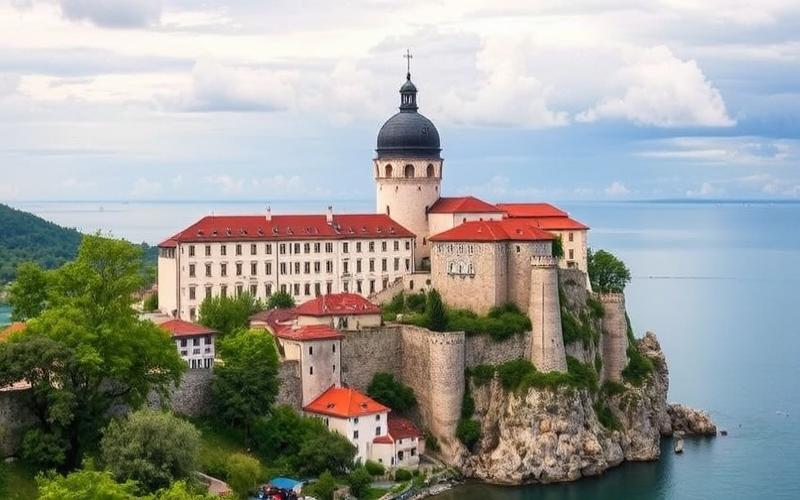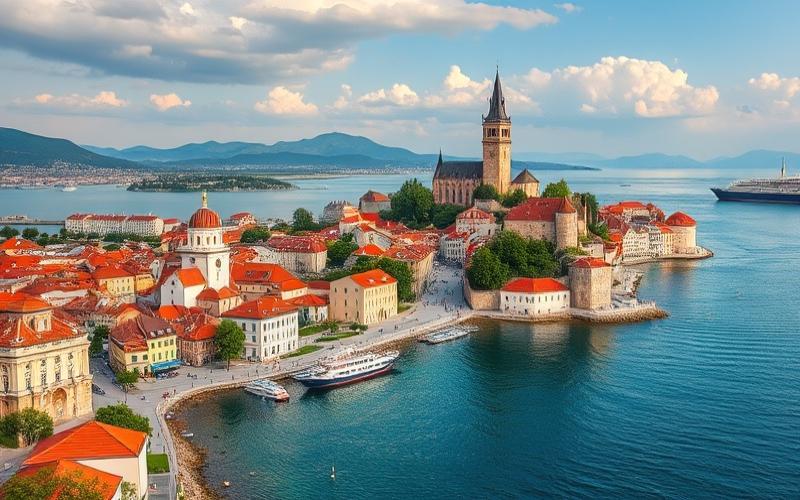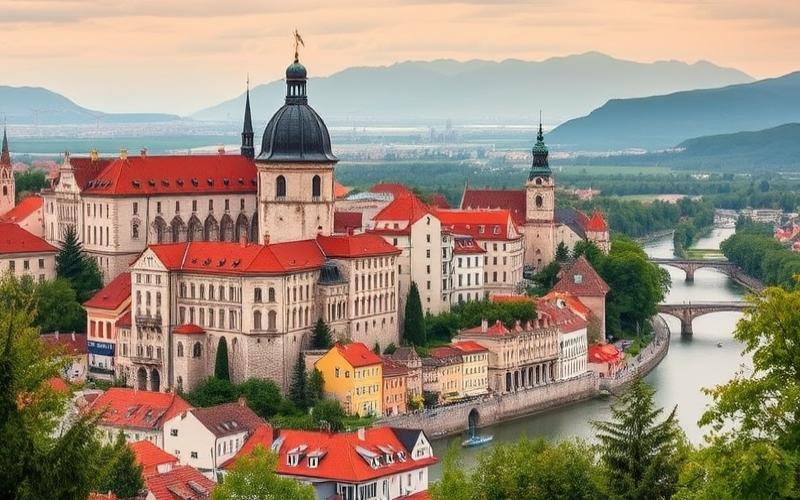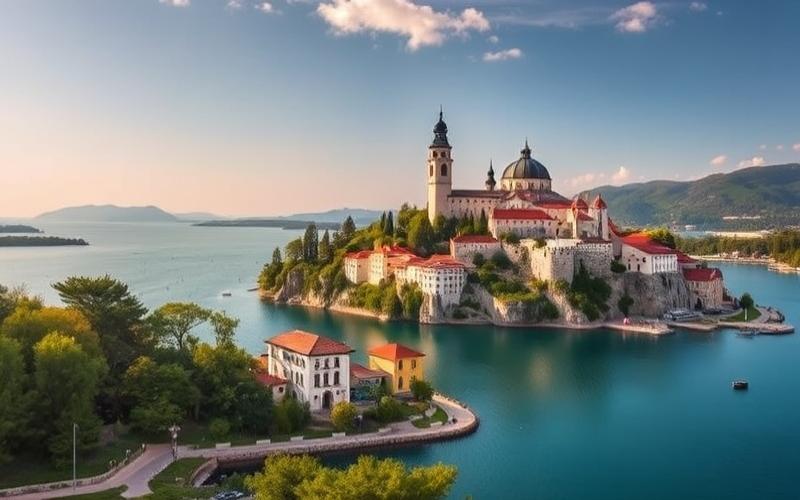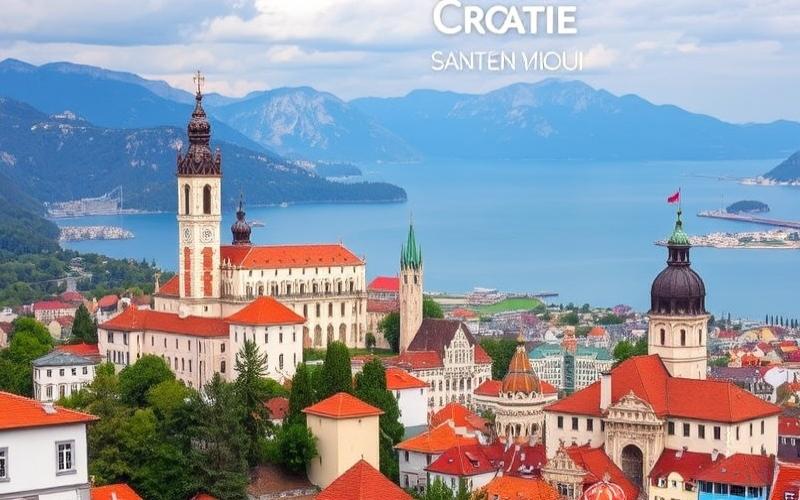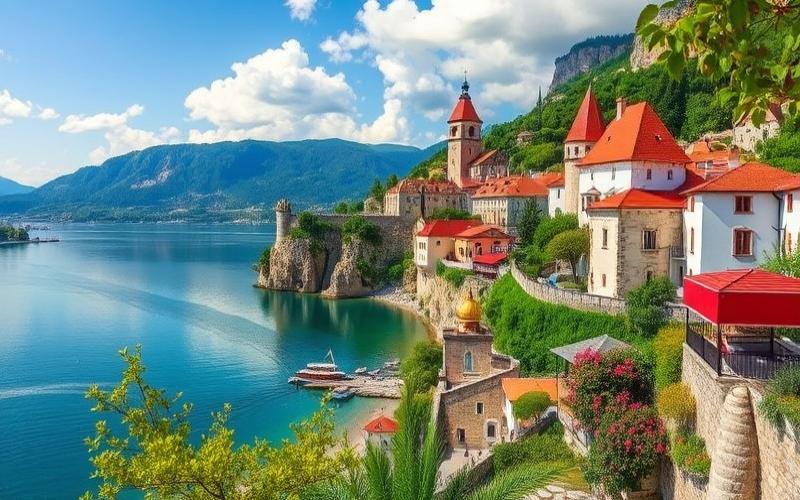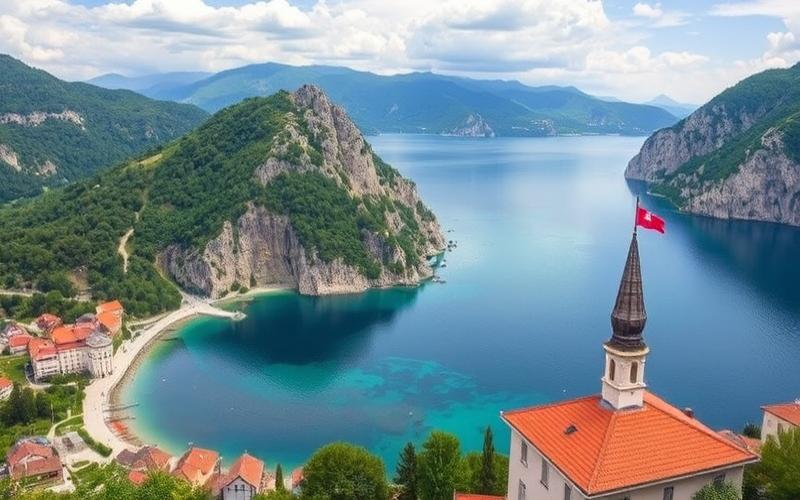
 Published on and written by Cyril Jarnias
Published on and written by Cyril Jarnias
Nestled in the heart of Europe, Croatia is a country whose rich and turbulent history reads like a true epic: from ancient times when Illyrian and Celtic tribes roamed its lands, to the majesty of the Roman Empire which left indelible marks through iconic sites such as Diocletian’s Palace in Split, to its strategic role at the crossroads of the Ottoman and Austro-Hungarian empires.
Dotted with stunning Adriatic coastlines and lush nature, Croatia is also a territory shaped by centuries of cultural influences, ranging from Catholicism to Yugoslav socialism.
Today, its fortified medieval cities like Dubrovnik, its cuisine rich in Mediterranean flavors, and its recent entry into the European Union testify to its ability to shine on the world stage while preserving a remarkable heritage.
Origins: The Birth of Croatia
The first human settlements in the Croatian region date back to the Neolithic period, with the Vucedol (Slavonia), Butmir (Bosnia), and Hvar (Dalmatia) civilizations. These sedentary societies practiced agriculture and livestock farming, leaving archaeological remains that testify to advanced social organization.
Main Illyrian and Celtic tribes settled in the territory:
- Dalmatians
- Taulantians
- Autariates
- Ardiaei
- Dardanians
- Labeates
- Penestae
- Daesitiates
- Liburnians
From the 5th century BC, Celtic tribes settled, particularly in the northern and central regions, mingling with the Illyrians.
Roman influence began with the gradual conquest of the Illyrian territory from the 2nd century BC. The Romans founded cities, built roads, and integrated the region into the Empire as the provinces of Dalmatia and Pannonia. Major remains include Diocletian’s Palace in Split and urban infrastructures, illustrating the Romanization of society, the expansion of Christianity, and the transformation of the political and cultural landscape.
In the 6th century, the arrival of the Slavs changed the demographics and social structure. The Croats, originating from these Slavic migrations, settled in the 7th century in the lands of the former Illyricum, as part of the great migrations prompted by the pressure from the Avars and Byzantines.
Chronological list of key stages:
- 12th century BC: Settlement of the Illyrians
- 5th century BC: Arrival of the Celts
- 2nd-1st century BC: Roman conquest
- 6th century: Arrival of the Slavs
- 7th century: Settlement of the Croats
The first Croatian state entities emerged in the 7th century, with the formation of duchies, including that of Croatia. These duchies were influenced by two major powers:
- The Byzantine Empire, which sought to maintain its control over the Adriatic coast and Dalmatia.
- The Frankish kingdoms, which extended their influence from the west and north.
Table of influences on the formation of the Duchy of Croatia:
| Influence | Main Characteristics |
|---|---|
| Byzantine | Control of the coast, Christianization, administrative model |
| Frankish | Political alliances, military and cultural influence |
| Roman | Urban heritage, infrastructure, Christianity |
In the 9th century, Prince Trpimir played a fundamental role in consolidating the Duchy of Croatia, laying the foundations for Croatian sovereignty. Under his reign, the Trpimirović dynasty established political continuity and asserted relative independence from neighboring powers.
The establishment of the Croatian kingdom occurred under the reign of Tomislav, crowned king at the beginning of the 10th century. Relations with Hungary, Bulgaria, and the Holy Roman Empire influenced the borders and politics of the young kingdom.
Analysis of the evolution of borders and Croatian identity:
- Medieval Croatia was born from the fusion of Illyrian, Celtic, Slavic, and Roman populations, each influence contributing to its cultural and political identity.
- Borders fluctuated according to alliances and conflicts with Byzantium, the Franks, Hungary, and the Bulgarians.
- The international recognition of the Croatian kingdom in the 11th century marked the culmination of this process, granting Croatia a distinct identity in the medieval European context.
The birth of Croatia is characterized by a succession of migrations, conquests, and cultural integrations, resulting in the formation of an independent kingdom with shifting borders and a plural identity.
Good to know:
The Slavs settled in the current Croatian territory around the 6th century, founding state entities that gave rise to the Duchy of Croatia in the 7th century, influenced by the Byzantines and Franks. The Croatian kingdom was officially recognized under the reign of Prince Trpimir in the 9th century, later interacting with neighboring powers like Hungary, shaping its borders and national identity.
From Dalmatia to Croatia: Between Invasions and Independence
Historical evolution of Dalmatia until its integration into the Croatian state
Dalmatia, a coastal region of the Adriatic, has experienced a complex history marked by numerous invasions and political transitions.
Main invasions and influences:
- The Romans annexed the region in the 1st century BC, founding cities such as Salona and Split, whose architecture (amphitheaters, roads, aqueducts) left a lasting mark on the landscape.
- In the 5th century, the Goths invaded the region, causing the decline of Roman structures and a period of instability.
- The Byzantines restored their authority in the 6th century, introducing Byzantine architectural elements and reinforced Christianization of the local populations.
- The Avars and Slavs arrived in the 7th century. The Slavs settled permanently, merging with the local populations and imposing their language and customs. This period saw the birth of the first Croatian entities in the region.
List of main influences and cultural transitions:
- Romanization: urbanization, Latinity, public buildings.
- Byzantinization: mosaics, fortifications, Orthodox religious influence.
- Slavicization: Romanesque churches, use of Church Slavonic, rural traditions.
Towards independence and major political movements
- In the Middle Ages, Dalmatia was contested between the Croatian kingdom, Hungary, and the Republic of Venice. In 1102, Croatia united with Hungary, but Dalmatia remained long coveted by Venice, which eventually controlled most of the coast, with the notable exception of Dubrovnik (Ragusa), an independent city.
- In 1358, the Peace of Zadar temporarily united Dalmatia with the Croatian-Hungarian crown.
- From the early 19th century, Dalmatia came under Austrian domination, then became the Kingdom of Dalmatia within the Austro-Hungarian Empire (1815-1918). The Austrian period favored the development of Croatian culture and a national renaissance, in reaction to Germanization and Magyarization.
Simplified chronological table:
| Period | Dominant Power | Architectural/Cultural Influence |
|---|---|---|
| Antiquity | Romans | Cities, amphitheaters, roads |
| 5th-6th centuries | Goths, Byzantines | Fortifications, mosaics |
| 7th century | Avars, Slavs | Romanesque churches, Slavic traditions |
| 1102-1420 | Croatia-Hungary/Venice | Venetian palaces, Dubrovnik’s autonomy |
| 1815-1918 | Austria-Hungary | Austro-Hungarian buildings, Croatian renaissance |
| 1918-1941 | Yugoslavia | Serbian influence, national tensions |
| 1941-1945 | Italy/Croatian State | Italian annexation, ethnic cleansing |
| 1945-1991 | Yugoslavia | Socialist urban planning, industrialization |
| 1991-1995 | Independent Croatia | Siege of Dubrovnik, modern reconstructions |
Dalmatia during the World Wars and the path to independence
- In 1918, the fall of the Austro-Hungarian Empire allowed the integration of Dalmatia into the Kingdom of Serbs, Croats, and Slovenes, the future Kingdom of Yugoslavia.
- During World War II, the region was partially annexed by Italy, then controlled by the Independent State of Croatia. After 1945, communist partisans retook the region, and ethnic cleansing struck the Italian minority.
- From 1945 to 1991, Dalmatia was part of the Socialist Republic of Croatia within Yugoslavia, undergoing socialist industrialization and urbanization.
- In 1991, Croatia declared its independence. Dalmatia became a major front during the war, notably with the siege of Dubrovnik and many heritage destructions.
Cultural transitions and major architectural influences
- Roman and Venetian influences remain visible in Split (Diocletian’s Palace), Trogir, Dubrovnik (city walls, palaces), while the Austro-Hungarian and Yugoslav periods are reflected in administrative buildings, railway infrastructure, and typical residential neighborhoods.
- The Yugoslav period left traces in brutalist architecture and modern memorial monuments.
- Since 1991, heritage restoration and the promotion of Croatian heritage have been priorities, with a strong emphasis on the region’s cultural diversity.
Dalmatia, a historical crossroads, retains an identity shaped by the succession of powers and the coexistence of cultures, visible in its cities, monuments, and traditions.
Good to know:
Dalmatia, gradually integrated into the Croatian state, saw its cultural and architectural landscape deeply marked by invasions from the Romans, Goths, Byzantines, Avars, and Slavs, each wave of influence leaving its mark before the region moved towards Croatian independence in 1991 after being under Austro-Hungarian influence.
The Impact of Foreign Powers: At the Crossroads of Empires
Croatia’s history is characterized by a succession of foreign influences and dominations, which deeply shaped its identity, culture, and institutions. From antiquity, the region was integrated into the Roman Empire, leaving an urban, legal, and linguistic heritage visible in cities like Split or Pula and in the use of Latin as a language of culture.
Main phases of foreign domination and their impacts on Croatia:
| Period / Power | Political Impact | Cultural Impact | Economic Impact |
|---|---|---|---|
| Roman Empire (1st-5th c.) | Integration into Romanity | Urbanization, Latinity, Christianization | Development of trade and infrastructure |
| Venetian Empire (1409-1797, Dalmatia) | Maritime control, urban administration | Architectural influence, religious art | Adriatic trade, urban prosperity |
| Ottoman Empire (15th-17th c.) | Territorial fragmentation, border zone, creation of the Military Frontier | Linguistic borrowings, religious coexistence, influence on literature | Economic decline in occupied areas, population displacement |
| Austro-Hungarian Empire (1527-1918) | Centralization, bureaucracy, modernization, relative autonomy | Germanization and Magyarization policies, development of modern Croatian culture | Industrialization, agrarian reform, railway infrastructure |
| Yugoslavia (1918-1991) | South Slavic unification, centralization, then federalism | Cultural blending, identity tensions | Industrial development, socialist planning |
| European Union (since 2013) | European political and economic integration | Promotion of multilingualism, heritage valorization | Modernization, foreign investments |
Ottoman influence:
Croatia was largely a border region of the Ottoman Empire from the 15th to the 17th century. Large portions of Slavonia, Lika, and western Bosnia were under Turkish domination, leading to major territorial losses and the creation of the Military Frontier, a buffer zone administered by Vienna and populated by various communities (Croats, Serbs, Vlachs, Germans).
Croatian culture adapted by preserving the language and Catholic faith through the action of the Church, while literature and poetry integrated Ottoman themes, testifying to a Croatian identity in resistance but also open to certain Eastern contributions.
Revolts against the Ottomans, such as the 1573 Peasants’ Revolt, became symbols of the struggle against foreign oppression.
Austro-Hungarian influence:
From the 16th century, Croatia gradually came under Habsburg domination after the Battle of Mohács. The Austrian administration brought political reforms, bureaucratic centralization, and relative autonomy for the military frontiers.
The linguistic policy of the Austro-Hungarian authorities aimed to create a supranational identity but also fostered the emergence of modern Croatian nationalism and cultural affirmation (rise of Croatian literature, language standardization).
The Croatian economy benefited from industrialization, railway development, and agrarian modernization but remained dependent on imperial centers.
Role of international powers during the Balkan Wars and the Cold War:
During the Balkan Wars (1912-1913), Croatia, then an integral part of the Austro-Hungarian Empire, underwent the geopolitical upheavals of the region, which foreshadowed the dissolution of the empire after World War I.
During the Cold War, Croatia, integrated into socialist Yugoslavia, found itself at the crossroads of Soviet and Western influences, while benefiting from a certain cultural and economic openness due to Tito’s non-aligned regime.
The intervention of Western and international powers in the 1990s was decisive for the recognition of Croatian independence and the end of the Yugoslav wars.
Legacy and modern identity:
The various dominations left deep traces in the architectural diversity (Roman cities, Venetian fortifications, Austro-Hungarian Baroque churches), religious plurality, coexistence of several languages and culinary traditions, as well as a national sentiment forged in resistance to assimilation.
Integration into the European Union, after a period of regained independence, symbolizes the culmination of a long process of emancipation, while opening Croatia to a new phase of external influences.
Main markers of Croatian cultural diversity inherited from foreign dominations:
- Multiple languages and dialects (standard Croatian, local dialects, Ottoman borrowings, Italianisms, Germanisms)
- Religious mix (Catholicism, Orthodoxy, Islam, Judaism)
- Architectural heritage (amphitheaters, palaces, fortresses, monasteries)
- Cuisine and folk traditions (Mediterranean, Balkan, Central European influences)
Today’s Croatia is the product of a history at the crossroads of empires, where the affirmation of national identity was built in confrontation and hybridization with the Other, giving rise to a culture of remarkable richness and diversity.
Good to know:
The Austro-Hungarian legacy is perceptible in Croatian architecture and administration, while Roman influence left a lasting impact on the legal system. Ottoman dominations enriched the culinary and musical heritage, merging with local traditions to create a unique culture.
Modern Croatia: From the Tumults of the 20th Century to Today
Croatia was deeply marked in the 20th century by a succession of major upheavals that shaped its identity and political destiny.
Key events of the 20th century:
- Integration into Yugoslavia after World War I, then forced inclusion in the Yugoslav socialist federation at the end of World War II.
- Rise of ethnic tensions in the late 1980s, exacerbated by the growing dominance of Serbia over federal institutions.
- Proclamation of Croatian independence on June 25, 1991, following a referendum largely approved by the Croatian population.
- Beginning of the Croatian War of Independence (1991-1995), pitting Croatia against the Yugoslav People’s Army (JNA) and local Serb forces supported by Belgrade. This war was marked by intense fighting, sieges, mass population displacements, and ethnic cleansing campaigns, particularly in Serb-controlled regions.
- Gradual recovery of territory by Croatian forces, notably during Operation Storm in 1995, followed by the peaceful reintegration of Eastern Slavonia in 1998.
Transition to an independent state:
After the war, Croatia had to rebuild its institutions, resettle displaced populations, and establish national cohesion.
Independence allowed for the consolidation of a nation-state but also left deep social and economic scars, particularly due to human losses and material destruction.
Process of accession to the European Union:
Croatia undertook a vast process of reforms to meet the European Union (EU) accession criteria:
- Institutional reforms: strengthening the rule of law, fighting corruption, judicial system reform.
- Economic reforms: privatizations, openness to foreign investment, infrastructure modernization.
Croatia became a member of the EU on July 1, 2013, thus consolidating its place in Europe and stimulating its economic and institutional development.
Impact of reforms on Croatian society:
| Sector | Reforms and Impacts |
|---|---|
| Economy | GDP growth, sector diversification, but persistent unemployment and youth emigration. |
| Politics | Institutional stabilization, political alternation, rise of new parties and civic movements. |
| Society | Improved standard of living, but regional inequalities and feelings of marginalization in some rural areas. |
Contemporary challenges and successes:
Challenges:
- Aging population and youth exodus to Western Europe.
- Economic dependence on tourism and vulnerability to external shocks (economic crises, pandemics).
- Persistent corruption and unfinished reforms in some public sectors.
Successes:
- Growth of the technology sector and entrepreneurial creativity.
- Active role in European and regional institutions.
- Gradual improvement of social and economic indicators.
Recent cultural and demographic evolutions:
Strengthening of a Croatian national identity, while valuing the cultural diversity inherited from various European, Mediterranean, and Balkan influences.
Demographic decline accentuated by emigration, but cultural dynamism, notably through festivals, artistic production, and sports.
Tourism in the modern Croatian economy:
Tourism represents an essential part of Croatia’s GDP, attracting millions of visitors each year drawn by the Adriatic coastline, historical heritage, and natural parks.
This sector stimulates employment and investments but also exposes the economy to strong seasonality and dependence on foreign markets.
| Key data on Croatian tourism |
|---|
| Over 20 million annual visitors (pre-pandemic) |
| Main destinations: Dubrovnik, Split, Istria, Dalmatian islands |
| Share of GDP: about 20% |
| Challenges: overcrowding, heritage preservation, diversification of offerings |
Croatia, shaped by the tumults of the 20th century, has established itself as a modern independent state through profound political and economic transition, successful accession to the European Union, and exceptional tourism dynamism, while facing the demographic, economic, and social challenges of a changing society.
Good to know:
Croatia, after overcoming the tumults of the dissolution of Yugoslavia and the war of independence in the 1990s, implemented significant reforms to join the European Union in 2013, thus stimulating its tourism-dominated economy, although challenges remain in modernizing infrastructure and addressing declining demographics.
Disclaimer: The information provided on this website is for informational purposes only and does not constitute financial, legal, or professional advice. We encourage you to consult qualified experts before making any investment, real estate, or expatriation decisions. Although we strive to maintain up-to-date and accurate information, we do not guarantee the completeness, accuracy, or timeliness of the proposed content. As investment and expatriation involve risks, we disclaim any liability for potential losses or damages arising from the use of this site. Your use of this site confirms your acceptance of these terms and your understanding of the associated risks.





